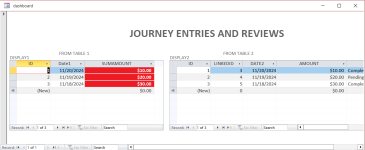Hi all.
I have two display forms (in datasheet view) on my dashboard.
Form1 and Form2 based on queries, with different two separate tables.
Form1 have an ID, DATE, and SUMAMOUNT
Form2 have many fields: ID, LINKED, DATE, AMOUNT, STATUS, ...etc
I'm trying to highlight the field in FORM1 SUMAMOUNT GREEN when
1. if the STATUS on FORM2 is equal to Completed.
2. Where the DATES are equal in Form1 and Form2 and
3. Where The SUMAMOUNT from Form1 and Amount from Form2 are equal
I'm trying to use the Expression builder in the conditional formatting to create an expression but i don't know how to create the expression.
I've don't know the syntax but i've try : IIF([FORM]![dashboard]![Form1].[SUMAMOUNT]=[FORM]![dashboard]![Form2].[AMOUNT],....??
Thanks for any help.
I have two display forms (in datasheet view) on my dashboard.
Form1 and Form2 based on queries, with different two separate tables.
Form1 have an ID, DATE, and SUMAMOUNT
Form2 have many fields: ID, LINKED, DATE, AMOUNT, STATUS, ...etc
I'm trying to highlight the field in FORM1 SUMAMOUNT GREEN when
1. if the STATUS on FORM2 is equal to Completed.
2. Where the DATES are equal in Form1 and Form2 and
3. Where The SUMAMOUNT from Form1 and Amount from Form2 are equal
I'm trying to use the Expression builder in the conditional formatting to create an expression but i don't know how to create the expression.
I've don't know the syntax but i've try : IIF([FORM]![dashboard]![Form1].[SUMAMOUNT]=[FORM]![dashboard]![Form2].[AMOUNT],....??
Thanks for any help.

